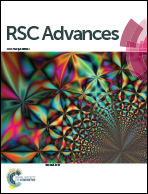Synthesis of a highly fluorescence nitrogen-doped carbon quantum dots bioimaging probe and its in vivo clearance and printing applications†
Abstract
Highly fluorescent, broad range pH and ionic-stable N-doped carbon quantum dots (N-CQDs) were successfully synthesized and their chemical structure and fluorescence mechanism were characterized. Mono-dispersed N-CQDs averaging 4.5 nm in diameter were achieved in a quantum yield (QY) of 74.16%. These N-CQDs showed great potential in biomedical and optical imaging applications both in vivo and in vitro. Biodistribution, retention, toxicity, and pharmacokinetics profiles are mandatory in their potential clinical applications. Herein, the biodistribution, clearance, and toxicity of our invariable N-CQDs species were systematically investigated over 7 days in mice. Most of the N-CQDs were cleared at 6 days post-injection without any accumulation in any vital organs or tissues. Moreover, the high fluorescence N-CQDs were demonstrated to be effective as printing inks for multicolour patterns. This study suggests that N-CQDs may be an attractive alternative to metal quantum dots for secure biomedical and other industrial applications.


 Please wait while we load your content...
Please wait while we load your content...